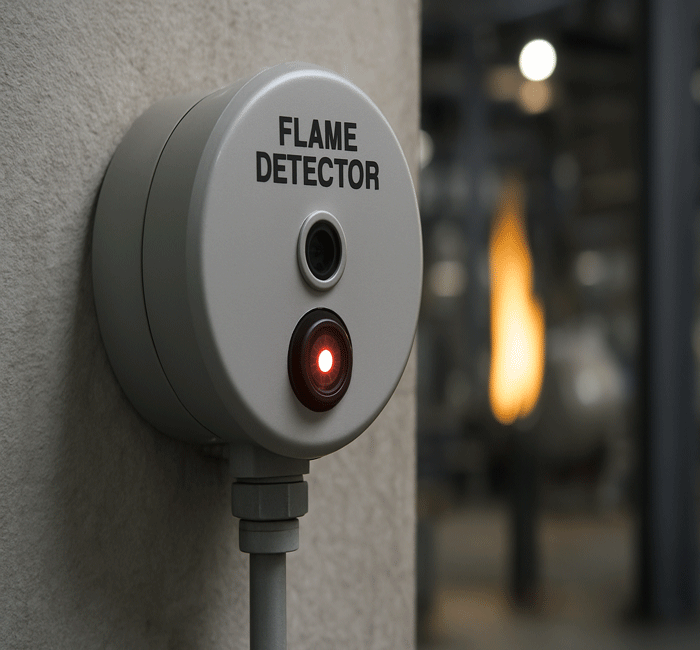Fire is both a significant benefit and a serious risk. Fire is a useful aid in cooking, generating energy, and warming ourselves, but it can also make homes, buildings, and lives disappear within mere minutes. That is why early detection of fire is paramount.
Of all of the devices we employ for protection, the flame detector serves as an additional and significant device. Unlike smoke or heat detection devices, flame detectors are design to monitor and respond to the light emitted by the fire, therefore it is much faster to respond and react to dangerous conditions.

What is a Flame Detector?
A flame detector is a device that uses electronic components to detect the light or radiation from a fire. Unlike smoke detectors that rely on visible smoke, or heat detectors that measure thermal changes, flame detectors can detect a fire in very short order. This is particularly useful in high-risk or dangerous situations where seconds matter, and it is common to utilize flame detectors in such situations.
How Does a Flame Detector Work?
The distinction arises because flames emit specific types of radiation. Flame detectors are tuned to (or are designed to catch) these signals:
- UV Flame Detectors – Detect ultra-violet radiation, and can do this in milliseconds after a flame has been detected;
- IR Flame Detectors – Detect infrared radiation, which is heat energy that is emitted;
- UV/IR Flame Detectors – Use a combination of these two flame methods to accurately detect flames, and reduce the possibility of false alarm levels.
This advanced detection is designed to be some fast that it can detect and react with these bigger open spaces or areas where smoke could take too long to activate detection technology.
How Does a Flame Detector Function?
It is really quite simple. Flames emit specific types of radiation. Flame detectors are designed to detect these signals:
- UV Flame Detectors – these are ultraviolet radiation detection devices that detect flames. UV radiation can be emitted in nanoseconds;
- IR Flame Detectors – these are infrared detection devices that detect the heat waves emitted by the flame;
- Combined UV/IR Detectors – these devices combine the two and provide the greatest amount of discrimination and the lowest rate of false alarms.
This advanced sensing is what allows the sense to respond quickly and timely even in large open spaces where smoke may take too long to reach alarm activation.
The Importance of Flame Detectors
- Rapid Reaction: Flame detectors will respond faster to incidents compared to ordinary fire detectors.
- Hazardous Environments: Flame detectors are suited for areas with flammable gas, fuel, or chemical hazards.
- Response Time: Giving you and others a few seconds of warning lets you escape, and the fire team respond.
- Less Damage: Identifying flame and quicker response times means less damage and smaller fires, instead of the fire’s growth.
- On Scene and Tough Conditions: Flame detectors work indoors or outdoors, and in dusty or smoky environments.
Where do we encounter usage of flame detectors?
- Factories and Workplaces (for safety of employees along with costly equipment).
- Oil and Gas Sites (for safety in hazardous, flammable environments).
- Airports and Hangars (because there are all open fuel sources and equipment could catch fire).
- Warehouse (to protect bulk goods, or raw materials).
- Public porches (large public spaces, or stadiums, because safety is paramount).
Flame Detector Close Up: A Silent Guardian
On closer inspection a flame detector is a small, uncomplicated device. Behind its seemingly simplistic exterior is an advanced array of sensors that never stop working. Every day and night they monitor the setting for the slightest evidence of danger. Their quick response could take the difference between a manageable incident to a major disaster.
Also read:-
